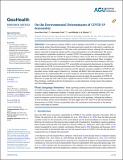| dc.contributor.author | Choi, Yeon‐Woo | |
| dc.contributor.author | Tuel, Alexandre | |
| dc.contributor.author | Eltahir, Elfatih A. B. | |
| dc.date.accessioned | 2021-06-11T20:55:14Z | |
| dc.date.available | 2021-06-11T20:55:14Z | |
| dc.date.issued | 2021-05 | |
| dc.date.submitted | 2021-03 | |
| dc.identifier.issn | 2471-1403 | |
| dc.identifier.uri | https://hdl.handle.net/1721.1/130936 | |
| dc.description.abstract | Viral respiratory diseases (VRDs), such as influenza and COVID-19, are thought to spread faster during winter than during summer. It has been previously argued that cold and dry conditions are more conducive to the transmission of VRDs than warm and humid climates, although this relationship appears restricted to temperate regions and the causal relationship is not well understood. The severe acute respiratory syndrome coronavirus 2 causing COVID-19 has emerged as a serious global public health problem after the first COVID-19 reports in Wuhan, China, in late 2019. It is still unclear whether this novel respiratory disease will ultimately prove to be a seasonal endemic disease. Here, we suggest that air drying capacity (ADC; an atmospheric state variable that controls the fate/evolution of the virus-laden droplets) and ultraviolet radiation (UV) are probable environmental determinants in shaping the transmission of COVID-19 at the seasonal time scale. These variables, unlike temperature and humidity, provide a physically based framework consistent with the apparent seasonal variability in COVID-19 and prevalent across a broad range of climates (e.g., Germany and India). Since this disease is known to be influenced by the compounding effect of social, biological, and environmental determinants, this study does not claim that these environmental determinants exclusively shape the seasonality of COVID-19. However, we argue that ADC and UV play a significant role in COVID-19 dynamics at the seasonal scale. These findings could help guide the development of a sound adaptation strategy against the pandemic over the coming seasons. | en_US |
| dc.publisher | American Geophysical Union (AGU) | en_US |
| dc.relation.isversionof | http://dx.doi.org/10.1029/2021gh000413 | en_US |
| dc.rights | Creative Commons Attribution-NonCommercial-NoDerivs License | en_US |
| dc.rights.uri | http://creativecommons.org/licenses/by-nc-nd/4.0/ | en_US |
| dc.source | American Geophysical Union (AGU) | en_US |
| dc.title | On the Environmental Determinants of COVID‐19 Seasonality | en_US |
| dc.type | Article | en_US |
| dc.identifier.citation | Choi, Yeon‐Woo et al. "On the Environmental Determinants of COVID‐19 Seasonality." GeoHealth 5, 6 (June 2021): e2021GH000413. © 2021 The Authors | en_US |
| dc.contributor.department | Parsons Laboratory for Environmental Science and Engineering (Massachusetts Institute of Technology) | en_US |
| dc.relation.journal | GeoHealth | en_US |
| dc.eprint.version | Final published version | en_US |
| dc.type.uri | http://purl.org/eprint/type/JournalArticle | en_US |
| eprint.status | http://purl.org/eprint/status/PeerReviewed | en_US |
| dspace.date.submission | 2021-06-10T14:35:12Z | |
| mit.journal.volume | 5 | en_US |
| mit.journal.issue | 6 | en_US |
| mit.license | PUBLISHER_CC | |
| mit.metadata.status | Complete | |
